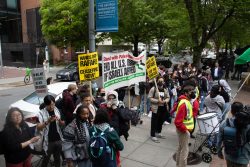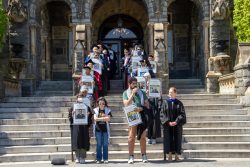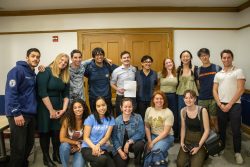At the January 20 ANC2E meeting to discuss the 2010 Campus Plan, D.C. Student Speak, a District-wide student blog, questioned whether Jennifer Altemus (COL ’88), the president of the Citizens Association of Georgetown, represents the citizens of Georgetown in opposing the plan. Citing the 169 signatures on the joint Burleith Citizens Association and Citizens Association of Georgetown, the students soon published a follow-up blog post calling on the “silent majority”—residents who do not agree with CAG’s opposition of the plan.
The petition has 169 signatures, CAG has 1,200 members, and the Burleith-Hillendale-Georgetown area houses 17,000 residents, according to the Washington Post. The rough population estimate suggests that fewer than one percent of residents signed the petition.
Erika Higley, an 11-year Glover Park resident, agrees with this “silent majority” theory.
“I talk to my neighbors [and] most are indifferent or supportive of [Georgetown University],” she said.
According to former ANC Commissioner Aaron Golds (COL’ 11), the issue is the definition of “constituency.” Golds argued that Altemus represents the membership of CAG, but he couldn’t determine her role in the larger community.
Ed Machir (MSB ‘74), a local resident, echoed Golds’s sentiment, maintaining that Altemus represents the most involved members of CAG.
“She probably represents that group of … 20 or 50 or 75 people who are very vocal. I’m not vocal; she doesn’t represent me,” he said.
Many residents enjoy living near a major university, according to Higley, who enrolled in a graduate program after moving to the neighborhood. She cites maintenance of home values, customers for local businesses, and ample education opportunities as benefits of living near a major university.
This reticent portion of the residents tends to express themselves in a more restrained manner, Golds added. Both he and Assistant Vice President in the Office for External Relations Linda Greenan have been contacted by various residents supporting the Campus Plan.
On the other hand, Machir, although he strongly supports the plan, has not been an active proponent because he felt biased as an alumnus and adjunct professor in the business school.
The other portion of the majority—the indifferent—do not keep up on the issue, according to Higley.
“Those who have no issues with the [Georgetown] have little incentive to get involved or even to fully inform themselves.”
Another aspect of the “silent majority” theory involves students, according to former commissioner Golds.
He claims, “While there is a silent majority who don’t really care or support the university, there is a silent majority of students whose neighbors don’t even know they’re there.”
Machir adds that the responsibility to enforce conduct of the vocal student minority lies with neither the students, the citizens, nor the citizens associations. Machir maintains this responsibility lies with the University.
Of the vocal neighbors, Higley speculates, “Those who speak out likely live near a particular problem house that they blame on [the University] or dislike the area bars and blame that on [the University].”
However, Machir also assessed Altemus’ leadership in other areas, asserting his lack of support for Altemus only extends to her adverse view of the university.
“I know that she must work extremely hard because I do see all the positive things and social things the Georgetown Citizens Association does, and they wouldn’t have those without the hard work of a president and the core volunteers, whoever that is—10, 15, 20—who make the place work,” he said. “I would have hoped that she, having been a student here, would understand the perspective.”






